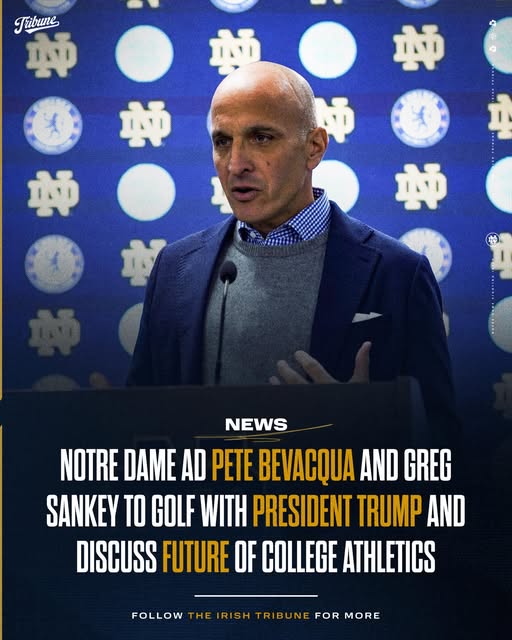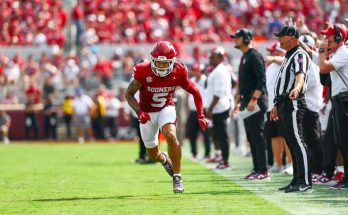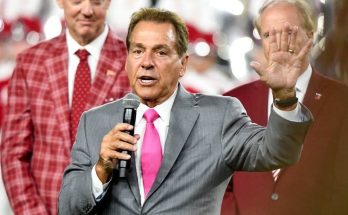Power and politics are colliding on the golf course in a way that could reshape the future of college athletics. In a high-stakes, behind-the-scenes move that has the attention of leaders across the sports world, Notre Dame athletic director Pete Bevacqua and SEC commissioner Greg Sankey are scheduled to meet with former President Donald Trump during an exclusive round of golf that insiders are calling “a power huddle on the links.” With the college football landscape shifting rapidly amid NIL chaos, conference realignment, playoff expansion, and political lobbying, this meeting represents more than just a friendly game—it’s a calculated convergence of influence, ambition, and leverage.
Sources close to the situation confirm the meeting will take place at one of Trump’s private golf courses, with all parties framing it as both casual and deeply consequential. Though the agenda has not been publicly disclosed, several high-ranking college athletics officials believe the discussion will center around the current direction of NCAA governance, the legal entanglements surrounding student-athlete compensation, and Notre Dame’s long-standing independence—an issue that could dramatically affect future media rights negotiations and playoff implications.
Bevacqua, who only recently took over as athletic director at Notre Dame, has already demonstrated a willingness to make bold moves and form high-level alliances. His corporate background, most notably as former chairman of NBC Sports, gives him a unique understanding of both media economics and the collegiate sports marketplace. Pairing that insight with Sankey’s ever-expanding influence as head of the SEC—the most dominant and profitable conference in college football—makes this meeting with Trump a convergence of two major decision-makers and one of the most polarizing and powerful political figures in America.
It’s no secret that Trump has long positioned himself as an ally to the traditional powers of college football. During his presidency, he frequently appeared at marquee games, including multiple SEC matchups, and often vocalized support for programs like Alabama, LSU, and even the broader culture of college football as a symbol of American strength. He has also weighed in on controversies surrounding COVID-era cancellations and NIL debates. With the upcoming election season heating up and Trump ramping up his public appearances, some believe this meeting could signal a renewed push by the former president to align himself with major college sports as a way to court votes, influence policy, and perhaps reassert himself as a kingmaker in collegiate governance.
But this isn’t just about optics. Legal experts say that future federal intervention in the NIL space is almost inevitable. With conflicting state laws, mounting lawsuits, and no unified framework from the NCAA, the calls for national standards have grown louder. Sankey himself has testified before Congress advocating for federal guidelines, arguing that the current patchwork of regulations threatens the competitive balance and long-term viability of college sports. Bevacqua, representing an institution like Notre Dame that straddles tradition and modern relevance, is seen as a powerful partner in that cause.
Notre Dame’s position has always been unique. As an independent in football with deep Catholic ties and its own media deal through NBC, the Fighting Irish have operated outside the typical conference system for decades. But with playoff expansion to 12 teams and pressure mounting from both the Big Ten and SEC, the program’s independence has become a focal point for debate. Some see it as a cherished legacy worth preserving. Others view it as an increasingly untenable outlier in a sport moving toward consolidation and super-conference dominance.
This meeting could serve as a pivot point for how Notre Dame proceeds. While Bevacqua has maintained the school’s commitment to independence, insiders say there’s growing awareness that a strategic partnership—perhaps even with the SEC—could provide the long-term stability and influence the Irish need to thrive in the next era of college sports. Sankey, always several steps ahead, may be laying the groundwork for exactly that kind of relationship. Trump, with his flair for spectacle and deal-making, could be the perfect figure to facilitate or publicly endorse such a seismic move.
Of course, not everyone is thrilled. Critics argue that any involvement of Trump in the college sports conversation only further politicizes an already fraught space. With recent comments from players, coaches, and university presidents about the dangers of excessive political interference, there is real concern that high-level backchannel meetings like this one could undermine more democratic or academic principles in favor of power grabs and media headlines. Others worry that discussions of NIL reform with political figures may tilt the scales too far toward centralization and federal overreach, especially given how diverse the athletic, academic, and legal interests are across the nation.
Still, for Sankey and Bevacqua, this meeting appears to be about long-term positioning. Sankey is clearly playing the long game in shaping the future of the SEC as the cornerstone of college athletics, while Bevacqua is still solidifying his own role as a major player after replacing longtime athletic director Jack Swarbrick. The two represent different backgrounds—corporate versus campus, southern versus northern, public powerhouse versus private legacy—but their mutual respect and shared understanding of college sports’ shifting dynamics could forge a formidable alliance.
It’s not lost on observers that this meeting is taking place on a golf course—an arena long used for quiet negotiations, unspoken agreements, and powerful symbolism. Trump’s courses have served as settings for everything from foreign diplomacy to legal maneuvering. In this case, it’s a potential merger of institutional gravitas, commercial interest, and political clout. Whatever the outcome, one thing is clear: the lines between college sports, politics, and big business are blurrier than ever.
Some speculate that this meeting may also be laying the groundwork for a possible summit or forum in the future. Imagine a televised panel discussion on the future of college sports, hosted at a Trump-branded resort, featuring Sankey, Bevacqua, major coaches, media executives, and political figures. Whether such an event would be informational or purely theatrical remains to be seen, but the possibility alone underscores the evolving landscape of influence and the stagecraft increasingly embedded in major college sports.
As schools like Florida State and Clemson battle their own conference futures and as the Big Ten continues to swell with new members, the SEC’s next move could be decisive in setting the tone for the next decade of college football. And if Notre Dame is indeed part of that calculus, this meeting with Trump could mark the first real shift in a process that ultimately brings the Irish under the SEC umbrella. Or, at the very least, establishes Notre Dame as a power broker willing to play ball with the sport’s titans.
There are also potential NIL implications. Trump has expressed interest in the NIL landscape before and has ties to influential figures in the sports and business worlds. His voice—backed by a strong media platform and a loyal base—could amplify efforts to standardize or restructure NIL systems in a way that appeals to both universities and lawmakers. For student-athletes, the idea of federal NIL reform is both promising and daunting. While some welcome the clarity and protection, others fear losing autonomy or becoming political pawns in a game they didn’t sign up for.
Regardless of the specific conversations that take place on the course, the very existence of this meeting underscores how far college sports have evolved. What was once a domain dominated by university boards and conference commissioners is now entangled with former presidents, billionaires, media conglomerates, and legal powerhouses. Decisions that affect players’ rights, academic missions, and regional identities are now being hashed out alongside discussions of TV revenue, political optics, and branding opportunities.
The image of Bevacqua, Sankey, and Trump walking side-by-side down a fairway will no doubt stir strong reactions. Supporters will see visionaries forging the future with bold leadership and strategic foresight. Critics will see power consolidation at its most brazen, where tradition and transparency are sacrificed for access and influence. But no one will deny the stakes.
College football has always been more than just a game. It’s a cultural institution, a regional identity, a business juggernaut, and increasingly, a political football of its own. In that context, a golf meeting among power players isn’t just a casual outing—it’s a chess move in a high-stakes game whose final rules have yet to be written. Whether it leads to a Notre Dame-SEC alliance, federal NIL legislation, or simply a deepening of ties between sport and politics, this “power huddle on the links” could very well be remembered as the start of the next chapter in the ever-evolving saga of college athletics.



